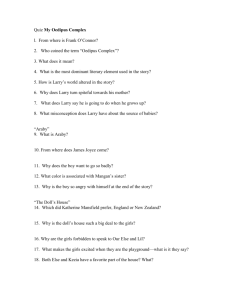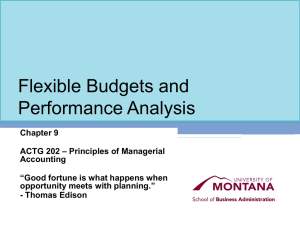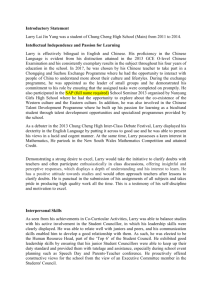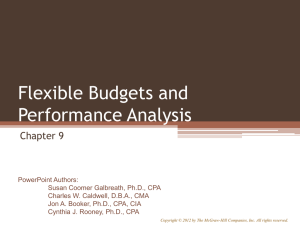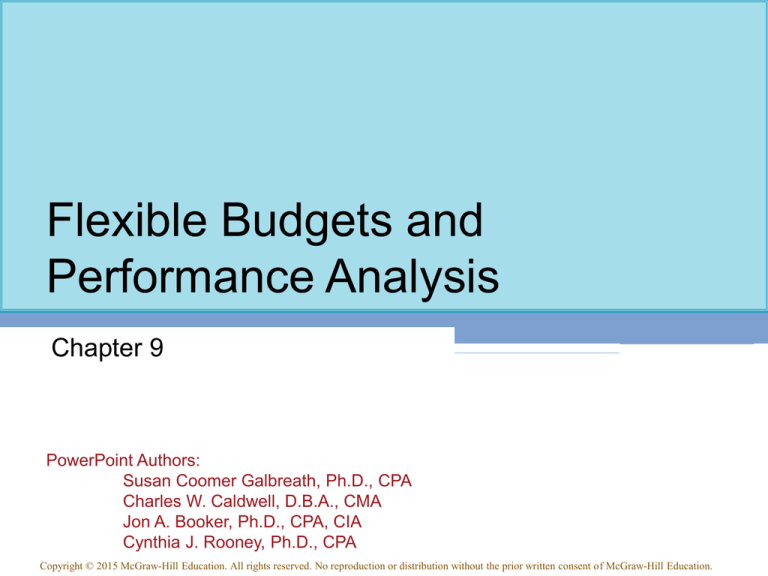
Flexible Budgets and
Performance Analysis
Chapter 9
PowerPoint Authors:
Susan Coomer Galbreath, Ph.D., CPA
Charles W. Caldwell, D.B.A., CMA
Jon A. Booker, Ph.D., CPA, CIA
Cynthia J. Rooney, Ph.D., CPA
Copyright © 2015 McGraw-Hill Education. All rights reserved. No reproduction or distribution without the prior written consent of McGraw-Hill Education.
9-2
Characteristics of Flexible Budgets
Planning budgets
are prepared for
a single, planned
level of activity.
Performance
evaluation is difficult
when actual activity
differs from the
planned level of
activity.
Hmm! Comparing
static planning budgets
with actual costs
is like comparing
apples and oranges.
9-3
Characteristics of Flexible Budgets
May be prepared for any activity
level in the relevant range.
Show costs that should have been
incurred at the actual level of
activity, enabling “apples to apples”
cost comparisons.
Help managers control costs.
Improve performance evaluation.
Let’s look at Larry’s Lawn Service.
9-4
Deficiencies of the Static Planning
Budget
Larry’s Lawn Service provides lawn care in a planned
community where all lawns are approximately the same size.
At the end of May, Larry prepared his June budget based on
mowing 500 lawns. Since all of the lawns are similar in size,
Larry felt that the number of lawns mowed in a month would
be the best way to measure overall activity for his business.
Larry’s Budget
9-5
Deficiencies of the Static Planning
Budget
Larry’s Planning Budget
9-6
Deficiencies of the Static Planning
Budget
Larry’s Actual Results Compared with the Planning Budget
9-7
Deficiencies of the Static Planning
Budget
Larry’s Actual Results Compared with the Planning Budget
Since these variances are unfavorable, has
Larry done a poor job controlling costs?
Since these variances are favorable, has
Larry done a good job controlling costs?
9-8
Deficiencies of the Static Planning
Budget
The relevant question is . . .
“How much of the cost variances are due to
higher activity and how much are due to cost
control?”
To answer the question,
we must
the budget to the
actual level of activity.
9-9
How a Flexible Budget Works
To
a budget, we need to know that:
▫ Total variable costs change
in direct proportion to
changes in activity.
▫ Total fixed costs remain
unchanged within the
relevant range.
Fixed
9-10
Preparing a Flexible Budget
Larry’s Flexible Budget
9-11
Activity Variances
Flexible
budget revenues
and expenses
Planning
budget revenues
and expenses
The differences between
the budget amounts are
called activity variances.
9-12
Activity Variances
Larry’s Flexible Budget Compared with the Planning Budget
9-13
Revenue and Spending Variances
Actual revenue
Flexible budget revenue
The difference is a revenue variance.
Actual cost
Flexible budget cost
The difference is a spending variance.
9-14
Revenue and Spending Variances
Larry’s Flexible Budget Compared with the Actual Results
$1,750 favorable
revenue variance
9-15
Revenue and Spending Variances
Larry’s Flexible Budget Compared with the Actual Results
Spending
variances
9-16
Flexible Budgets with Multiple Cost
Drivers
More than one cost
driver may be needed to
adequately explain all of
the costs in an organization.
The cost formulas used
to prepare a flexible
budget can be adjusted
to recognize multiple
cost drivers.
9-17
Flexible Budgets with Multiple Cost
Drivers
Because the time required for edging and trimming is different for
different lawns, Larry decided to add an additional cost driver
(hours) for the time required for edging and trimming. So Larry
estimated the additional hours and developed a new flexible
budget that includes the second cost driver in both his revenue
and expense budget formulas.
Larry’s New Budget
9-18
Flexible Budgets with Multiple Cost
Drivers
Larry’s Budget Based on More than One Cost Driver
9-19
Some Common Errors
The most common errors when preparing performance
reports are to implicitly assume that:
1. All costs are fixed, or that;
2. All costs are variable.
Assume all costs are fixed.
9-20
Common Error 1: Assuming All Costs
Are Fixed
Faulty Analysis Comparing Budgeted Amounts to Actual Amounts
9-21
Common Error 2: Assuming All Costs
Are Variable
Faulty Analysis that Assumes All Budget Items Are Variable
9-22
End of Chapter 9

